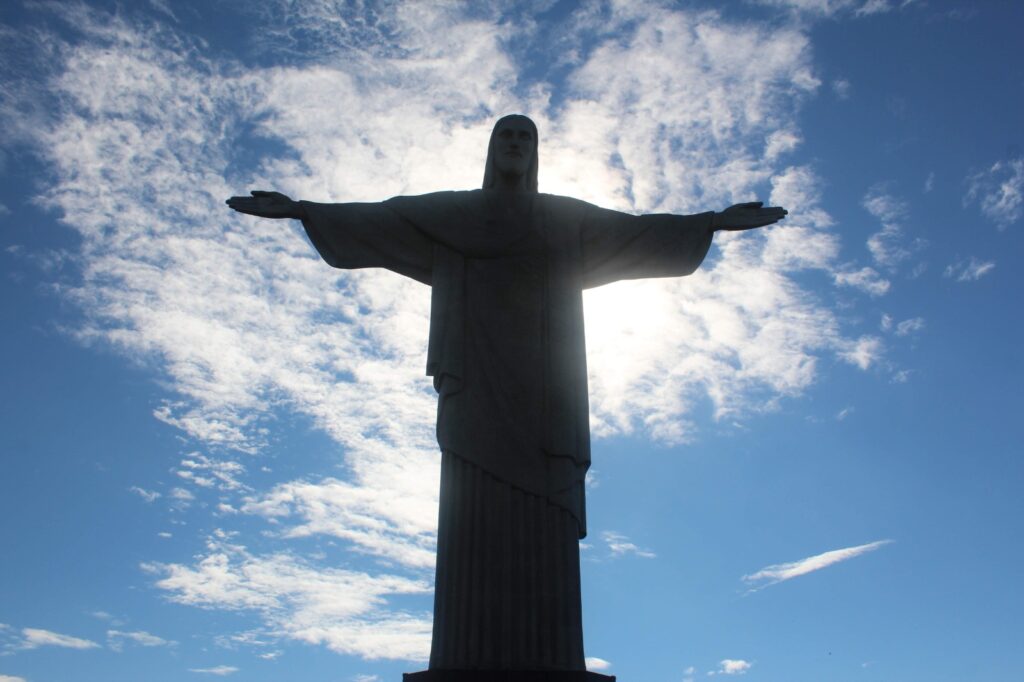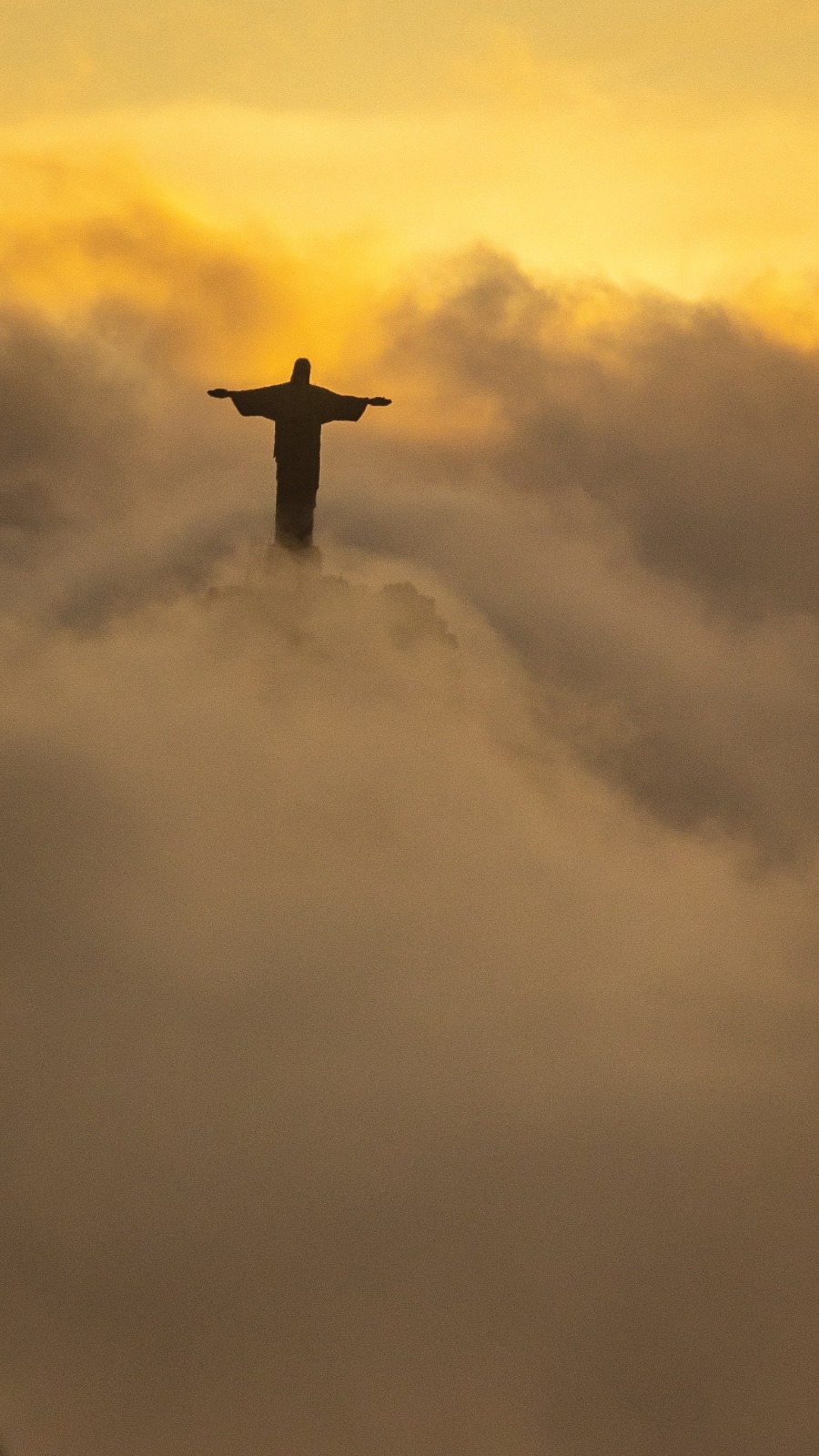In Brazil Jesus Statue nestled atop Rio de Janeiro’s Corcovado mountain, officially known as Christ the Redeemer (Cristo Redentor), stands as an iconic testament to faith and artistic brilliance. Crafted between 1922 and 1931, this Art Deco masterpiece was envisioned by French sculptor Paul Landowski, with contributions from Romanian sculptor Gheorghe Leonida and Brazilian engineer Heitor da Silva Costa, alongside French engineer Albert Caquot. The statue, made from reinforced concrete and soapstone, soars 30 meters high, excluding its 8-meter pedestal, with arms outstretched 28 meters wide.
Originally conceived with a globe and cross, Christ the Redeemer evolved into the awe-inspiring figure we see today, arms wide open in a gesture of embracing the world. Weighing a staggering 635 metric tons, this monumental statue has become a global symbol of Christianity, drawing pilgrims and tourists alike to witness its grandeur.
Perched at an altitude of 700 meters within the lush embrace of Tijuca National Park, the Brazil Jesus Statue not only overlooks the captivating city of Rio de Janeiro but also stands as the largest Art Deco style sculpture globally. Its cultural significance extends beyond religious boundaries, making it an emblem of both Rio de Janeiro’s spirit and Brazil’s rich heritage. Notably, it has earned the prestigious title of being one of the New Seven Wonders of the World, further solidifying its place in history and the hearts of millions. Join us in exploring the profound fusion of faith, art, and engineering that embodies the awe-inspiring Brazil Jesus Statue, a marvel that continues to inspire and captivate the world.
Brazil Jesus Statue :The Enigmatic History
The captivating history of Brazil’s iconic Jesus Statue, or Christ the Redeemer (Cristo Redentor), is a tale intertwined with faith, determination, and artistic vision. It all began with a suggestion in the mid-1850s by Vincentian priest Pedro Maria Boss, who envisioned a Christian monument atop Mount Corcovado to honor Princess Isabel, the regent of Brazil and daughter of Emperor Pedro II. However, the project faced rejection.
Fast forward to 1920 when the Catholic Circle of Rio initiated a proposal for a monumental statue on the same mountain. Their motivation stemmed from a perceived “Godlessness” in society, and they organized the Semana do Monumento (“Monument Week”) to gather donations and support. The initial design concepts ranged from a representation of the Christian cross to a statue of Jesus holding a globe, but what ultimately graced the mountaintop was the statue of Christ the Redeemer with open arms, symbolizing peace.
The collaborative effort of local engineer Heitor da Silva Costa, artist Carlos Oswald, and French sculptor Paul Landowski brought this vision to life. Romanian sculptor Gheorghe Leonida, a student of sculpture in Bucharest and Italy, joined the project. The choice of materials, including reinforced concrete and enduring soapstone, contributed to the statue’s longevity.
Construction, which spanned from 1922 to 1931, demanded dedication and approximately US$250,000 in funding. On October 12, 1931, the monument was unveiled, with plans for its illumination remotely controlled by Italian shortwave radio inventor Guglielmo Marconi, although weather conditions shifted the responsibility to on-site activation.
Throughout its history, the statue weathered lightning strikes that prompted restoration efforts, including the replacement of soapstone layers and lightning rods. A significant restoration project in 2010 addressed cleaning, mortar and soapstone replacement, internal iron structure restoration, and waterproofing.
Despite occasional challenges, this iconic statue remains a symbol of faith, artistry, and Brazil’s cultural heritage, attracting visitors from around the globe and leaving an indelible mark on history.

In Brazil Jesus Statue Preservation: Restoring Magnificence and Cultural Heritage
The enduring magnificence of Brazil’s Jesus Statue, Christ the Redeemer, on Corcovado Mountain is not just a testament to human creativity but also a symbol of continuous care and preservation. In 1990, a collaborative effort by entities like the Archdiocese of Rio de Janeiro, Grupo Globo, Shell do Brasil, IBAMA, National Institute of Historic and Artistic Heritage, and Rio de Janeiro’s city government was initiated for its restoration.
Over the years, restoration initiatives became essential to maintain the statue’s grandeur. In 2003, escalators, walkways, and elevators were strategically installed to enhance accessibility, ensuring visitors could marvel at this iconic structure comfortably. The meticulous restoration in 2010 focused on the statue’s core. Skilled artisans worked diligently, renovating its internal structure and meticulously restoring the soapstone mosaic, which involved delicately removing fungi and repairing minor cracks. The lightning rods, crucial for the statue’s safety, were meticulously repaired, and modern lighting fixtures were installed, illuminating the statue in vibrant green and yellow hues during special occasions, such as the 2010 FIFA World Cup in support of the Brazilian national football team.
This restoration endeavor engaged a dedicated team of more than a hundred individuals who utilized over 60,000 stone pieces sourced from the same quarry as the original statue. The meticulous process aimed not only to restore but also to preserve the statue’s authentic essence. However, the task is ongoing, necessitated by the statue’s exposure to strong winds, erosion, and lightning strikes. Replacement stones, though slightly darker, are sourced to ensure the statue retains its structural integrity and timeless allure. Thus, through careful restoration, Brazil’s Jesus Statue continues to stand tall, captivating the world with its grace and splendor.

In Brazil Jesus Statue: Unraveling its Profound Cultural Significance
There is a major significance of Brazil’s Jesus statue also known as Christ the Reedeemer , few of them are mentioned below .
- Religious Pilgrimages: Christ the Redeemer is visited by many religious pilgrims, especially during significant Christian events like Easter. Pilgrims climb the Corcovado Mountain as an act of devotion, showcasing the statue’s religious importance.
- Festivals: While there might not be specific festivals associated with the statue, major Brazilian festivals like Carnival often incorporate Christ the Redeemer in their themes and celebrations, symbolizing faith and unity among the people.
- Local Celebrations: Locals often celebrate the statue’s anniversary with cultural events, music, and dance. Additionally, the statue is illuminated on special occasions, creating a vibrant atmosphere in Rio de Janeiro.
- Tourism and Cultural Exchange: Christ the Redeemer serves as a cultural ambassador, attracting tourists from around the world. Visitors often learn about Brazil’s rich cultural heritage, including its diverse music, dance, and traditions.
- Artistic Representations: The statue has inspired various forms of art, literature, and music in Brazil. Artists often depict the statue in their works, celebrating its cultural and religious significance.



